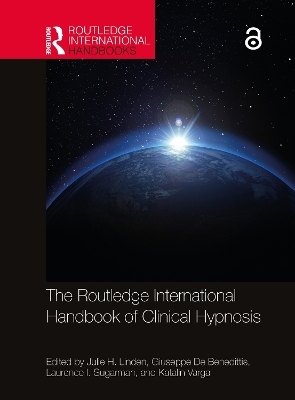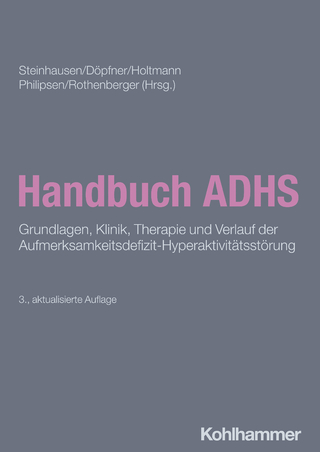
The Routledge International Handbook of Clinical Hypnosis
Routledge (Verlag)
978-1-032-31140-1 (ISBN)
It contains state-of-the-art neuroscience, cutting-edge practice, and future-oriented visions of clinical hypnosis integrated into all aspects of health and clinical care. Chapters gather current research, theories, and applications in order to view clinical hypnosis through the lens of neurobiological plasticity and reveal the central role of hypnosis in health care. This handbook catalogs the utility of clinical hypnosis as a biopsychosocial intervention amid a broad range of treatment modalities and contexts. It features contributions from esteemed international contributors, covering topics such as self-hypnosis, key theories of hypnosis, hypnosis and trauma, hypnosis and chronic pain management, attachment, and more.
This handbook is essential for researchers, clinicians, and newcomers to clinical hypnosis, in medical schools, hospitals, and other healthcare settings.
Chapters 4, 35, 62 and 63 of this book are freely available as a downloadable Open Access PDF at http://www.taylorfrancis.com under a Creative Commons Attribution-Non Commercial-No Derivatives (CC-BY-NC-ND) 4.0 license.
Julie H. Linden, PhD, is a psychologist and past president of the International Society of Clinical Hypnosis. She teaches globally about incorporating hypnosis skills into all aspects of healthcare practice. Giuseppe De Benedittis, MD, PhD, is associate professor of Neurosurgery at the University of Milano, Italy. He is internationally recognized as one of the leading experts in pain therapy and as a pioneer in the clinical and experimental use of hypnosis for pain control, contributing to the elucidation of the complex neurophysiological mechanisms of hypnotic analgesia. Laurence I. Sugarman, MD, is a pediatrician and research professor at the Rochester Institute of Technology's College of Health Sciences and Technology. He studies, writes, and teaches globally about integrating therapeutic hypnosis into clinical care. Katalin Varga, PhD, DSc, is a psychologist and past president of the Hungarian Association of Hypnosis and a board member of the International Society of Clinical Hypnosis. She is a hypnosis researcher and Ericksonian psychotherapist, as well as a teacher of the application of suggestive techniques in various fields.
Introduction Section I: The Roots of Contemporary Clinical Hypnosis 1. Brief History of World Hypnosis 2. On the Hard Process of Understanding Hypnosis: Epistemological Issues in the Debate between State, Trait, and Hypofrontality Theories 3. Suggestibility and Hypnotizability Measures of Hypnosis and Hypnotizability Theoretical Models 4. The Contributions of Milton Erickson to Modern Clinical Hypnosis 5. Attachment and Hypnosis: Revisiting our Evolutionary Past to Reconstruct Our Future 6. Mind, Self, and Hypnosis: A Relational Theory 7. From Phenomenology to Noetic Analysis: The Use of Quantitative First-Person Self-Reports to Better Understand Hypnosis 8. States of Consciousness Model and Ericksonian Approaches to Hypnosis 9. The Foundation of an Ecological Model of Hypnotherapy: the Base for Defining the Structural Dimensions of Hypnotherapy 10. An Empirically-Informed Integrative Theory of Hypnosis: Clinical Implications From Theory to the Art of Practice 11. Rapid Hypnotic Inductions 12. Self-Hypnosis 13. Hypnosis: A Developmental Perspective 14. Hypnosis and Integrative Aspects of Music 15. Utilization of Metaphor as a Therapeutic Tool Section II: The Neuroscientific Foundations of Hypnosis Neural Correlates of Hypnosis 16. Neural Correlates of Hypnosis 17. EEG Oscillatory Activity Concomitant with Hypnosis and Hypnotizability 18. Beyond the Neural Signature of Hypnosis: Neuroimaging Studies Support a Multifaceted View of Hypnotic Phenomena 19. The Neurochemical Bases of Verbal Suggestion and Hypnosis Hypnotizability 20. The Neuropsychology of Hypnotizability 21. The Physiological Correlates of Hypnotizability 22. Types of High Hypnotizables 23. Alteration of Hypnotic Phenomena and Hypnotizability with Non-Invasive Brain Stimulation (NIBS): State-of-the-Art and Future Perspectives Mechanisms of Hypnotic Analgesia 24. How Can We Better Understand Hypnosis and Its Modulation of Pain with Neuroimaging? 25. EEG-Assessed Bandwidth Power and Hypnotic Analgesia Research in Hypnosis 26. Conducting Research in Clinical Hypnosis 27. The Potential Role of Hypnosis and Neurofeedback in Linking Neuroscience to Psychotherapy Section III: Clinical Hypnosis in Practice Behavioral and Affective Change 28. Clinical Hypnosis and Anxiety 29. Applying Hypnosis Strategically in Treating Depression 30. The Hypnotic Lens on Trauma and Treatment 31. Eating Disorders: Using Hypnotic Techniques and Rapport to Treat Anorexia and Bulimia Nervosa 32. The Promise of Hypnosis Within CBT for Smoking Cessation 33. Systemic Hypnosis: How to Develop and Use Systemic Trances with Couples and Families 34. A Systemic View: Hypnosis to Solve Problems of Overweight and Obesity Children and Adolescents 35. Hypnosis in the Treatment of Functional Somatic Symptoms in Children and Adolescents 36. Hypnosis: Finding Relief for Children and Teens in Pain 37. Clinical Use of Hypnosis in Pediatric Dentistry Medicine 38. Hypnodontics 39. Hypnosis in Pediatric and Adult Pulmonology 40. Hypnosis in Neurological Disorders and Neurorehabilitation 41. Hypnosis for Skin Disorders 42. Hypnosis in Gastroenterology 43. Hypnosis and Chronic Pain Management 44. Hypnosis and Fibromyalgia Syndrome 45. A Suggestive Presence during Labor and Birth 46. Hypnosis in Surgery: The Socio-Psycho-Biological Model of Surgical Hypnosis 47. Perioperative Medical Interventions and Devices 48. Bleeding, Hemostasis: Suggestive Techniques 49. Epilepsy, Stroke and Psychoses after Traumatic Brain Injury 50. Hypnosis in the Intensive Care Unit: Utilization of the Superorganismic Connection State 51. Clinical Hypnosis in Palliative Care Section IV: Frontiers of Hypnosis Hypnosis and Society Efforts, Pitfalls, and Criteria to Build a Bridge Between Hypnosis and Medicine 53. Understanding the Dark Side of Hypnosis as a Form of Undue Influence Exerted in Authoritarian Cults and Online Contexts: Implications for Practice, Policy, and Education 54. The Image of Hypnosis: Public Perception of the Negative Aspects of Trance Professional Development 55. How to Encourage Self-Care in Helping Professionals through Process-Oriented Hypnosis 56. Mindfulness Meditation and Hypnosis in Clinical Practice: An Integrated Approach 57. Advancing Education in Clinical Hypnosis 58. A Model of Training in Clinical Hypnosis Grounded in Interpersonal Neurobiology 59. Professional Training and Development in Pediatric Hypnosis: What We Have Learned and How to Make It Better 60. Placebo and Nocebo Effects: Implications for Hypnosis 61. Hypnosis and the Future of the World's Children 62. Actual Favorite Places 63. Hypnotic Horizons
| Erscheinungsdatum | 06.02.2024 |
|---|---|
| Reihe/Serie | Routledge International Handbooks |
| Zusatzinfo | 32 Tables, black and white; 24 Line drawings, black and white; 6 Halftones, black and white; 30 Illustrations, black and white |
| Verlagsort | London |
| Sprache | englisch |
| Maße | 174 x 246 mm |
| Gewicht | 2080 g |
| Themenwelt | Geisteswissenschaften ► Psychologie ► Biopsychologie / Neurowissenschaften |
| Geisteswissenschaften ► Psychologie ► Humanistische Psychotherapien | |
| Medizin / Pharmazie ► Medizinische Fachgebiete ► Psychiatrie / Psychotherapie | |
| ISBN-10 | 1-032-31140-1 / 1032311401 |
| ISBN-13 | 978-1-032-31140-1 / 9781032311401 |
| Zustand | Neuware |
| Informationen gemäß Produktsicherheitsverordnung (GPSR) | |
| Haben Sie eine Frage zum Produkt? |
aus dem Bereich


